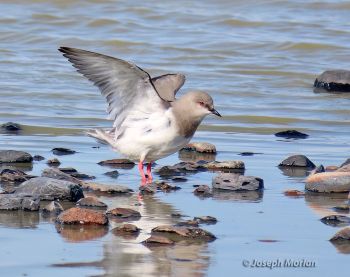- Pluvianellus socialis
Identification

Laguna Verde, Tierra del Fuego, Magellanes y Antarctica Chileno, Chile, 6 November 2013

Photo © by Joseph Morlan
Laguna los Palos, Punta Arenas, Magellanes, Chile, 17 January 2023
Length: 19½-21½ cm (7¾-8½ in)
- Grey head, neck, chest and upper parts
- Whitish throat and cheeks
- Brown tint on neck and chest
- White abdomen and under tail coverts
- Blackish primaries and rectrices
- Black bill. Pink legs. Red eyes.
Males and females are alike, although the female averages smaller. Juveniles have their upperparts spotted and extensively fringed with white and their breast is slightly streaked with dark grey. Their lores are pale and lack the dark line. Bare parts are duller with the bill showing extensive yellow culmen. Eyes are orange-grey. Legs and feet are more yellowish than on adults.
Distribution
South America breeds in Tierra del Fuego, southern Argentina, and extreme southern Chile. It winters north to the Valdés Peninsula, sometimes as far as Buenos Aires Province in Argentina.
Taxonomy
Not actually a plover; this species is the sole member of its own family the Pluvianellidae. It is a monotypic species[1].
Habitat
Edges of brackish lakes and lagoons, ponds, estuaries and coastal areas.
Behaviour
Actions
Pecks food from surface turning over small stones, seaweeds, shells and debris with its strong bill to find food. It also uses its legs and feet to scratch or dig into the sand for hidden prey, a behaviour unique among waders.
Diet
Shrimp, sandhoppers (amphipod crustacean of sandy shores) and tiny arthropods.
Breeding
They use a hollow in the ground to lay 2 eggs, which are grey with dusky spots, which have all the appearance of stones. Both adults incubate the eggs and care for the young. Adults secrete a crop milk not unlike that of doves to feed their young.
Vocalisations
Most common call is a ringing coo or ceu sounding like a cross between a dove and a plover. Also an ascending whistle weeEEEEooooo. Alarm call is a pip-wheet.
Movements
Resident, dispersive and migratory. After the breeding season they move to the coast north to the Valdés Peninsula and occasionally to southwest Buenos Aires Province, Argentina and Falkland Islands.
References
- Clements, J. F., T. S. Schulenberg, M. J. Iliff, D. Roberson, T. A. Fredericks, B. L. Sullivan, and C. L. Wood. 2018. The eBird/Clements checklist of birds of the world: v2018. Downloaded from http://www.birds.cornell.edu/clementschecklist/download/
- avesdechile
- Jaramillo, A. 2003. Birds of Chile. Princeton & Oxford: Princeton Univ. Press. ISBN 978-0691117409
- Magellanic Plover (Pluvianellus socialis), In Neotropical Birds Online (T. S. Schulenberg, Editor). Cornell Lab of Ornithology, Ithaca, NY, USA. retrieved from Neotropical Birds Online: https://neotropical.birds.cornell.edu/Species-Account/nb/species/magplo1
- Wiersma, P. & Kirwan, G.M. (2019). Magellanic Plover (Pluvianellus socialis). In: del Hoyo, J., Elliott, A., Sargatal, J., Christie, D.A. & de Juana, E. (eds.). Handbook of the Birds of the World Alive. Lynx Edicions, Barcelona. (retrieved from https://www.hbw.com/node/53859 on 17 January 2019).
Recommended Citation
- BirdForum Opus contributors. (2025) Magellanic Plover. In: BirdForum, the forum for wild birds and birding. Retrieved 28 April 2025 from https://www.birdforum.net/opus/Magellanic_Plover
External Links
GSearch checked for 2020 platform.1




